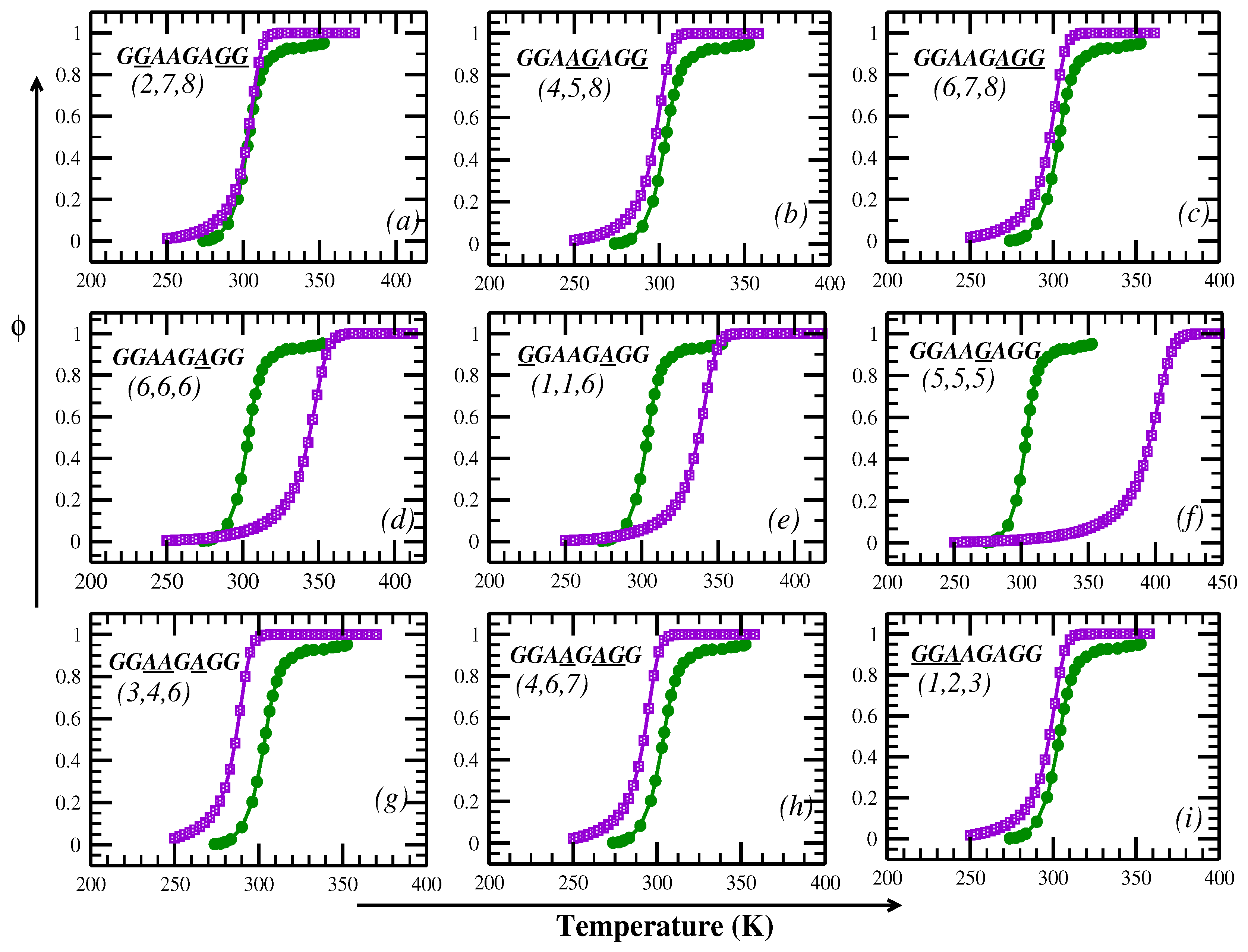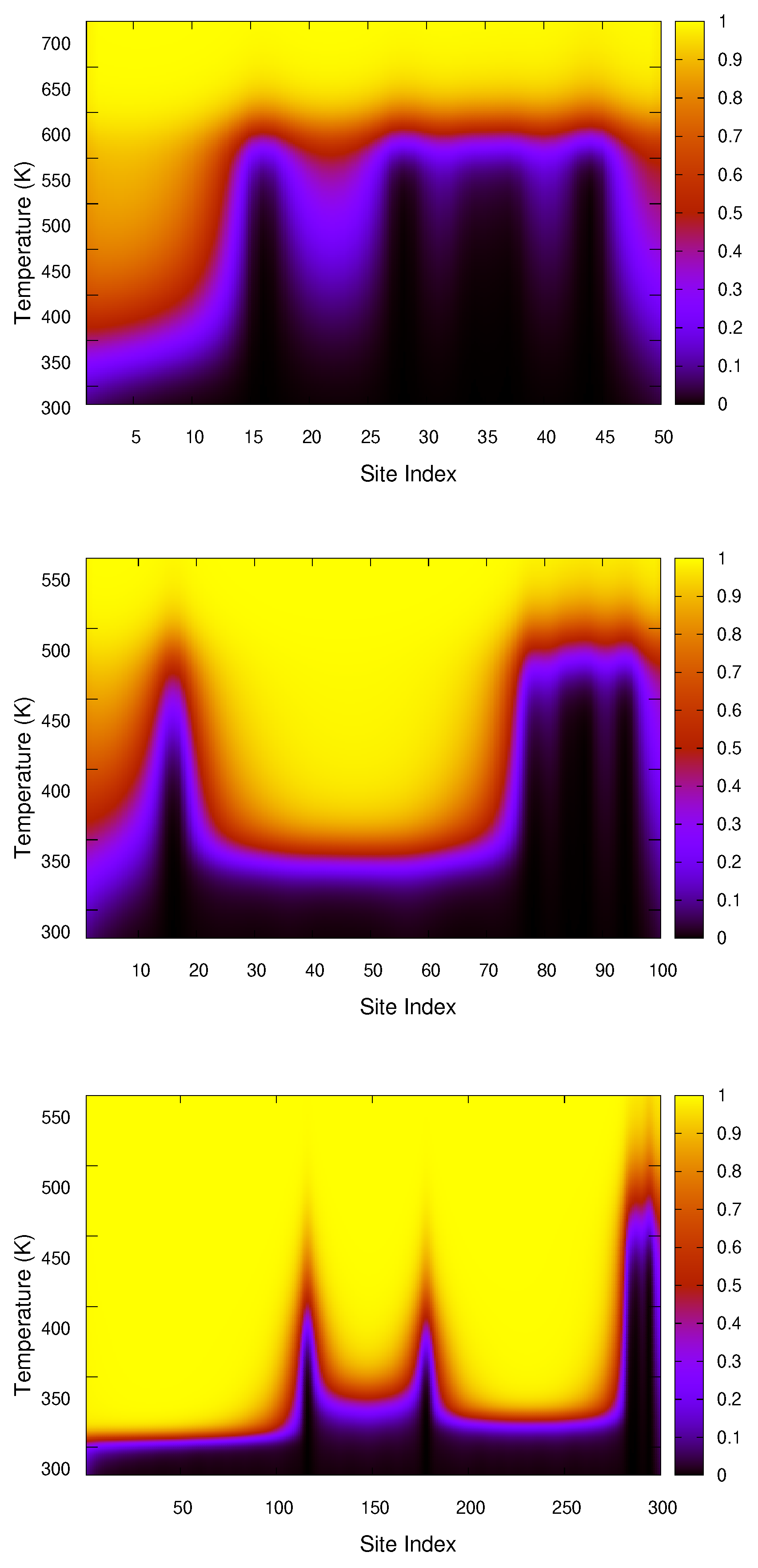Melting Profile of DNA in Crowded Solution: Model-Based Study
Abstract
1. Introduction
2. Results and Discussion
2.1. Melting of Short DNA Duplex
2.2. Melting of Long DNA Duplex
3. Materials and Methods
4. Conclusions
Supplementary Materials
Author Contributions
Funding
Institutional Review Board Statement
Informed Consent Statement
Data Availability Statement
Acknowledgments
Conflicts of Interest
References
- Rivas, G.; Minton, A.P. Toward an understanding of biochemical equilibria within living cells. Biophys. Rev. 2018, 10, 241–253. [Google Scholar] [CrossRef] [PubMed]
- Kim, J.; Jeon, C.; Jeong, H.; Jung, Y.; Ha, B.Y. A polymer in a crowded and confined space: Effects of crowder size and poly-dispersity. Soft Matter 2015, 11, 1877–1888. [Google Scholar] [CrossRef] [PubMed]
- Akabayov, B.; Akabayov, S.R.; Lee, S.J.; Wagner, G.; Richardson, C.C. Impact of macromolecular crowding on DNA replication. Nat. Commun. 2013, 4, 1615. [Google Scholar] [CrossRef]
- Alfano, C.; Fichou, Y.; Huber, K.; Weiss, M.; Spruijt, E.; Ebbinghaus, S.; De Luca, G.; Morando, M.A.; Vetri, V.; Temussi, P.A.; et al. Molecular Crowding: The History and Development of a Scientific Paradigm. Chem. Rev. 2024, 124, 3186–3219. [Google Scholar] [CrossRef]
- Xu, G.; Cheng, K.; Liu, M.; Li, C. Studying protein stability in crowded environments by NMR. Prog. Nucl. Magn. Reson. Spectrosc. 2024, 140–141, 42–48. [Google Scholar] [CrossRef]
- Bhattacharya, A.; Kim, Y.C.; Mittal, J. Protein–protein interactions in a crowded environment. Biophys. Rev. 2013, 5, 99–108. [Google Scholar] [CrossRef]
- Singh, A.; Kundrotas, P.J.; Vakser, I.A. Diffusion of proteins in crowded solutions studied by docking-based modeling. J. Chem. Phys. 2024, 161, 095101. [Google Scholar] [CrossRef]
- Singh, A.; Maity, A.; Singh, N. Structure and Dynamics of dsDNA in Cell-like Environments. Entropy 2022, 24, 1587. [Google Scholar] [CrossRef]
- Endoh, T.; Tateishi-Karimata, H.; Sugimoto, N. Effects of Molecular Crowding on Structures and Functions of Nucleic Acids. In Handbook of Chemical Biology of Nucleic Acids; Sugimoto, N., Ed.; Springer Nature: Singapore, 2022; pp. 1–45. [Google Scholar]
- de Vries, R. DNA condensation in bacteria: Interplay between macromolecular crowding and nucleoid proteins. Biochimie 2010, 92, 1715–1721. [Google Scholar] [CrossRef]
- Takahashi, S.; Herdwijn, P.; Sugimoto, N. Effect of Molecular Crowding on DNA Polymerase Reactions along Unnatural DNA Templates. Molecules 2020, 25, 4120. [Google Scholar] [CrossRef]
- Majumdar, D. Influence of Media Disorder on DNA Melting: A Monte Carlo Study. J. Chem. Theory Comput. 2025, 21, 2021–2029. [Google Scholar] [CrossRef] [PubMed]
- Singh, A.; Singh, N. DNA melting in the presence of molecular crowders. Phys. Chem. Chem. Phys. 2017, 19, 19452–19460. [Google Scholar] [CrossRef] [PubMed]
- Mondal, S.; Mishra, P.P. Direct observation of effect of crowding induced macromolecular hydration on molecular breathing in the stem of Fork-DNA by single-molecule FRET microspectroscopy. Int. J. Biol. Macromol. 2021, 167, 559–569. [Google Scholar] [CrossRef]
- Mathur, N.; Singh, A.; Singh, N. Force-induced unzipping of DNA in the presence of solvent molecules. Biophys. Chem. 2024, 307, 107175. [Google Scholar] [CrossRef]
- Sardana, D.; Alam, P.; Yadav, K.; Clovis, N.S.; Kumar, P.; Sen, S. Unusual similarity of DNA solvation dynamics in high-salinity crowding with divalent cations of varying concentrations. Phys. Chem. Chem. Phys. 2023, 25, 27744–27755. [Google Scholar] [CrossRef]
- Maity, A.; Singh, A.; Singh, N. Differential stability of DNA based on salt concentration. Eur. Biophys. J. 2017, 46, 33–40. [Google Scholar] [CrossRef]
- Mardoum, W.M.; Gorczyca, S.M.; Regan, K.E.; Wu, T.C.; Robertson-Anderson, R.M. Crowding Induces Entropically-Driven Changes to DNA Dynamics That Depend on Crowder Structure and Ionic Conditions. Front. Phys. 2018, 6, 53. [Google Scholar] [CrossRef]
- Ghosh, S.; Takahashi, S.; Ohyama, T.; Endoh, T.; Tateishi-Karimata, H.; Sugimoto, N. Nearest-neighbor parameters for predicting DNA duplex stability in diverse molecular crowding conditions. Proc. Natl. Acad. Sci. USA 2020, 117, 14194–14201. [Google Scholar] [CrossRef]
- Forties, R.A.; Bundschuh, R.; Poirier, M.G. The flexibility of locally melted DNA. Nucleic Acids Res. 2009, 37, 4580–4586. [Google Scholar] [CrossRef]
- Rivetti, C.; Walker, C.; Bustamante, C. Polymer chain statistics and conformational analysis of DNA molecules with bends or sections of different flexibility. J. Mol. Biol. 1998, 280, 41–59. [Google Scholar] [CrossRef]
- Clausen-Schaumann, H.; Rief, M.; Tolksdorf, C.; Gaub, H.E. Mechanical Stability of Single DNA Molecules. Biophys. J. 2000, 78, 1997–2007. [Google Scholar] [CrossRef] [PubMed]
- Poland, D.; Scheraga, H.A. Phase Transitions in One Dimension and the Helix—Coil Transition in Polyamino Acids. J. Chem. Phys. 1966, 45, 1456–1463. [Google Scholar] [CrossRef] [PubMed]
- Peyrard, M.; Bishop, A.R. Statistical mechanics of a nonlinear model for DNA denaturation. Phys. Rev. Lett. 1989, 62, 2755–2758. [Google Scholar] [CrossRef] [PubMed]
- Collette, D.; Dunlap, D.; Finzi, L. Macromolecular Crowding and DNA: Bridging the Gap between In Vitro and In Vivo. Int. J. Mol. Sci. 2023, 24, 17502. [Google Scholar] [CrossRef]
- Ke, Y.; Sharma, E.; Wayment-Steele, H.K.; Becker, W.R.; Ho, A.; Marklund, E.; Greenleaf, W.J. High-Throughput DNA melt measurements enable improved models of DNA folding thermodynamics. bioRxiv 2024. [Google Scholar] [CrossRef]
- de Oliveira Martins, E.; Weber, G. Nearest-neighbour parametrization of DNA single, double and triple mismatches at low sodium concentration. Biophys. Chem. 2024, 306, 107156. [Google Scholar] [CrossRef]
- Harris, S.A.; Sands, Z.A.; Laughton, C.A. Molecular Dynamics Simulations of Duplex Stretching Reveal the Importance of Entropy in Determining the Biomechanical Properties of DNA. Biophys. J. 2005, 88, 1684–1691. [Google Scholar] [CrossRef]
- Poppleton, E.; Romero, R.; Mallya, A.; Rovigatti, L.; Šulc, P. OxDNA.org: A public webserver for coarse-grained simulations of DNA and RNA nanostructures. Nucleic Acids Res. 2021, 49, W491–W498. [Google Scholar] [CrossRef]
- Dauxois, T.; Peyrard, M.; Bishop, A.R. Entropy-driven DNA denaturation. Phys. Rev. E 1993, 47, R44–R47. [Google Scholar] [CrossRef]
- Manghi, M.; Destainville, N. Physics of base-pairing dynamics in DNA. Phys. Rep. 2016, 631, 1–41. [Google Scholar] [CrossRef]
- Singh, A.; Modi, T.; Singh, N. Opening of DNA chain due to force applied on different locations. Phys. Rev. E 2016, 94, 032410. [Google Scholar] [CrossRef] [PubMed]
- Frank-Kamenetskii, M.D.; Prakash, S. Fluctuations in the DNA double helix: A critical review. Phys. Life Rev. 2014, 11, 153–170. [Google Scholar] [CrossRef] [PubMed]
- Kabir, A.; Bhattarai, M.; Rasmussen, K.; Shehu, A.; Usheva, A.; Bishop, A.R.; Alexandrov, B. Examining DNA breathing with pyDNA-EPBD. Bioinformatics 2023, 39, btad699. [Google Scholar] [CrossRef] [PubMed]
- Singh, A.; Singh, N. Effect of salt concentration on the stability of heterogeneous DNA. Phys. A Stat. Mech. Its Appl. 2015, 419, 328–334. [Google Scholar] [CrossRef]
- Zoli, M. Thermodynamics of twisted DNA with solvent interaction. J. Chem. Phys. 2011, 135, 115101. [Google Scholar] [CrossRef]
- Macedo, D.; Guedes, I.; Albuquerque, E. Thermal properties of a DNA denaturation with solvent interaction. Phys. A Stat. Mech. Its Appl. 2014, 404, 234–241. [Google Scholar] [CrossRef]
- Weber, G. Sharp DNA denaturation due to solvent interaction. EPL (Europhys. Lett.) 2006, 73, 806. [Google Scholar] [CrossRef]
- Singh, A.; Singh, N. Phase diagram of mechanically stretched DNA: The salt effect. Phys. A Stat. Mech. Its Appl. 2013, 392, 2052–2059. [Google Scholar] [CrossRef]
- Khairani, R.; Dwiputra, D.; Hidayat, W.; Zen, F.P. Effect of Solvent on Stretching and Twisting of DNA. J. Phys. Conf. Ser. 2019, 1127, 012013. [Google Scholar] [CrossRef]
- Ngoubi, H.; Ben-Bolie, G.H.; Kofané, T.C. Charge transport in a DNA model with solvent interaction. J. Biol. Phys. 2018, 44, 483–500. [Google Scholar] [CrossRef]
- Singh, A.; Singh, N. Pulling DNA: The Effect of Chain Length on the Mechanical Stability of DNA Chain. Macromol. Symp. 2015, 357, 64–69. [Google Scholar] [CrossRef]
- Zoli, M. Fluctuations cutoff in a 1D Hamiltonian model for DNA. Phys. Scr. 2024, 99, 095009. [Google Scholar] [CrossRef]
- Campa, A.; Giansanti, A. Experimental tests of the Peyrard-Bishop model applied to the melting of very short DNA chains. Phys. Rev. E 1998, 58, 3585–3588. [Google Scholar] [CrossRef]
- Cocco, S.; Monasson, R. Statistical Mechanics of Torque Induced Denaturation of DNA. Phys. Rev. Lett. 1999, 83, 5178–5181. [Google Scholar] [CrossRef]
- Zoli, M. First-passage probability: A test for DNA Hamiltonian parameters. Phys. Chem. Chem. Phys. 2020, 22, 26901–26909. [Google Scholar] [CrossRef]
- Zhang, Y.l.; Zheng, W.M.; Liu, J.X.; Chen, Y.Z. Theory of DNA melting based on the Peyrard-Bishop model. Phys. Rev. E 1997, 56, 7100–7115. [Google Scholar] [CrossRef]
- van Erp, T.S.; Cuesta-Lopez, S.; Peyrard, M. Bubbles and denaturation in DNA. Eur. Phys. J. E 2006, 20, 421–434. [Google Scholar] [CrossRef]
- Singh, A.; Singh, N. Pulling short DNA molecules having defects on different locations. Phys. Rev. E 2015, 92, 032703. [Google Scholar] [CrossRef]





Disclaimer/Publisher’s Note: The statements, opinions and data contained in all publications are solely those of the individual author(s) and contributor(s) and not of MDPI and/or the editor(s). MDPI and/or the editor(s) disclaim responsibility for any injury to people or property resulting from any ideas, methods, instructions or products referred to in the content. |
© 2025 by the authors. Licensee MDPI, Basel, Switzerland. This article is an open access article distributed under the terms and conditions of the Creative Commons Attribution (CC BY) license (https://creativecommons.org/licenses/by/4.0/).
Share and Cite
Mathur, N.; Singh, A.; Singh, N. Melting Profile of DNA in Crowded Solution: Model-Based Study. Int. J. Mol. Sci. 2025, 26, 5305. https://doi.org/10.3390/ijms26115305
Mathur N, Singh A, Singh N. Melting Profile of DNA in Crowded Solution: Model-Based Study. International Journal of Molecular Sciences. 2025; 26(11):5305. https://doi.org/10.3390/ijms26115305
Chicago/Turabian StyleMathur, Neha, Amar Singh, and Navin Singh. 2025. "Melting Profile of DNA in Crowded Solution: Model-Based Study" International Journal of Molecular Sciences 26, no. 11: 5305. https://doi.org/10.3390/ijms26115305
APA StyleMathur, N., Singh, A., & Singh, N. (2025). Melting Profile of DNA in Crowded Solution: Model-Based Study. International Journal of Molecular Sciences, 26(11), 5305. https://doi.org/10.3390/ijms26115305





